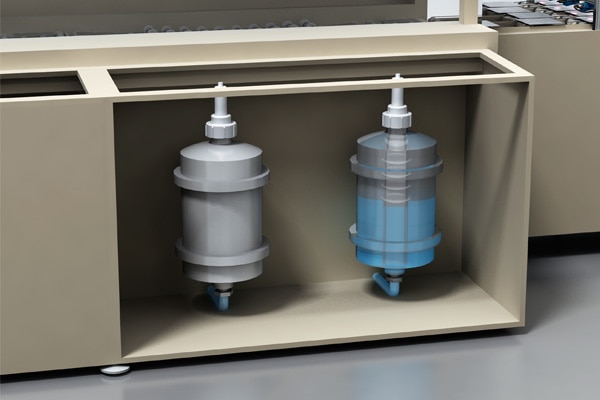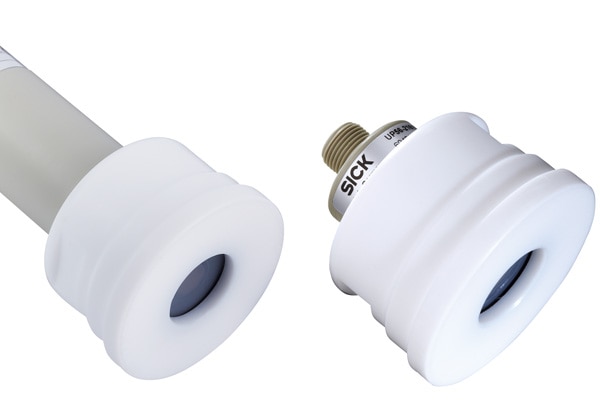In many industries, challenging ambient conditions of all kinds are part of everyday production. The systems and sensors that are responsible for keeping the production process safe have to be specially protected against severe contamination or aggressive chemicals. For instance, chemicals are an unavoidable part of solar cell production, where they are central to core processes such as solar wafer surface finishing and cleaning. The levels in the chemical tanks have to be constantly monitored by sensors. The Teflon®-coated UP56 Pure ultrasonic level sensors deliver precise results on a non-stop basis. Chemicals for semiconductor and solar cell production are stored close to where they are needed inside storage and mixing tanks on wet processing machines. However, this makes them difficult to access. A common method of determining the level is to use capacitive sensors. The sensors are placed externally on the wall of the tank or on a bypass pipe and are thus protected from the chemicals. Usually, several sensors are mounted on the tank at different heights and are aligned manually. Although they signal limit levels, they are not capable of continuous level measurement.  Chemicals being stored in hard-to-access tanks.
Chemicals being stored in hard-to-access tanks.
Ultrasonic technology inside the tank
Nevertheless, precise and continuous level measurement is an absolute necessity when working with aggressive chemicals to ensure the safety and reliability of the process. And that is why SICK has developed a solution based on ultrasonic technology that allows continuous level measurement between the switching points. The non-contact ultrasonic level sensors of the UP56 Pure product family are a range of specialized products for wet chemical processes in the electronics and solar industries. Their PTFE materials protect the ultrasonic sensor from aggressive liquids. Polytetrafluoroethylene (PTFE) - also known as Teflon® - is a special type of plastic that is frequently used in wet processing machines. The transducer of the level sensor has a PTFE coating while the connection flange is made from solid PTFE. As a result, the UP56 Pure can be placed directly inside the immersion pipe at the top of the tanks interior. Using ultrasonic waves, it measures the distance between the sensor and the liquid and signals levels continuously. Any changes in the level of the liquid are detected by the sensor immediately. In plants with confined installation spaces the UP56 Pure Mini is the perfect solution thanks to its very compact design.
 UP56 Pure and UP56 Pure Mini ultrasonic level sensors.
UP56 Pure and UP56 Pure Mini ultrasonic level sensors.
Precise, efficient, and maintenance friendly
Due to its PTFE-protected transducer, the UP56 Pure is very hardwearing and durable, making it ideal for use in highly concentrated acids and alkalis. Once installed directly inside the tank, the UP56 eliminates the need for additional accessories such as external bypass pipes or measuring shafts. Also, because only one sensor is required, it is no longer necessary to position several capacitive sensors mechanically (a process that is prone to errors). UP56 Pure fits seamlessly into the machine sequences, and its digital and analog outputs make light work of the electrical connections. The ultrasonic sensor features a standard flange and is fixed in place with a coupling nut. This means it is mechanically compatible with all the connections that are typically encountered within the industry. Software is included so that the sensor can be programmed to suit the specific customer and application. The responsible employee can use the software to adjust the parameters in line with the production situation and can optimize the refill times. This increases process safety and reliability, helps to ensure the sustainable use of resources, and minimizes production costs: Not only does the accurate measurement of chemical consumption prevent production downtime due to empty tanks; it also avoids wasting chemicals by refilling the tanks unnecessarily.
Ruggedness on demand
Working in conjunction with its customers, SICK checks exactly what operating conditions the UP56 Pure is going to face once it is installed in the respective production environment. The resulting combination of extensive sensor expertise and optimum knowledge of the process enables a customized approach to sensor implementation with a minimum of effort and expense. Moreover, rugged products from SICK can be used to secure wet chemical processes in other locations as well. For example, Teflon®-coated capacitive proximity sensors from the CM18 PTFE product family are able to detect leaks in the safety collecting basin underneath the chemical tank. If any leaks occur or if chemicals flow into the safety sump trays, the sensors detect the problem and signal it via the machine controller so that it can be immediately remedied by service personnel.
- Product information: UP56 Pure, CM18 PTFE
- Product portfolio: Füllstandsensoren, Kapazitive Näherungssensoren

